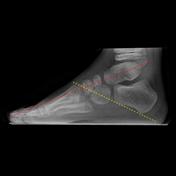Hibbs angle
Updates to Article Attributes
Title
was changed:
Hibb's angle
Body
was changed:
Hibb's angle angle has been used to identify the apex of deformity in patients with pes cavus on lateral weight bearing radiograph. Hibb's angle angle is formed betweenby the line representinglines running along the long axes of of the calcaneum andcalcaneus and the first metatarsal. The intersection of the lines represents apex of the deformity.
Normally Hibb's angle angle is greater than 150 degrees. Hibb's angle angle less than 150 degrees indicates pes cavus.
-<p><strong>Hibb's angle </strong>has been used to identify the apex of deformity in patients with <a href="/articles/pes-cavus">pes cavus</a> on lateral weight bearing radiograph. Hibb's angle is formed between the line representing the long axes of the calcaneum and the first metatarsal. The intersection of the lines represents apex of the deformity.</p><p>Normally Hibb's angle is greater than 150 degrees<sup> </sup>. Hibb's angle less than 150 degrees<sup> </sup> indicates <a href="/articles/pes-cavus">pes cavus</a>.</p>- +<p><strong>Hibb angle </strong>has been used to identify the apex of deformity in patients with <a href="/articles/pes-cavus">pes cavus</a> on lateral weight bearing radiograph. Hibb angle is formed by the lines running along the axes of the calcaneus and the first metatarsal. The intersection of the lines represents apex of the deformity.</p><p>Normally Hibb angle is greater than 150 degrees. Hibb angle less than 150 degrees<sup> </sup> indicates <a href="/articles/pes-cavus">pes cavus</a>.</p>
Images Changes:
Image 1 Annotated image (Lateral talocalcaneal angle) ( update )

Caption
was changed:
Case 1: Hibb's angle







 Unable to process the form. Check for errors and try again.
Unable to process the form. Check for errors and try again.